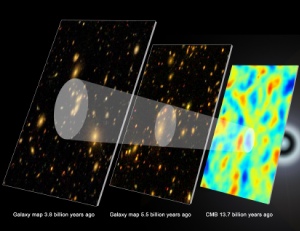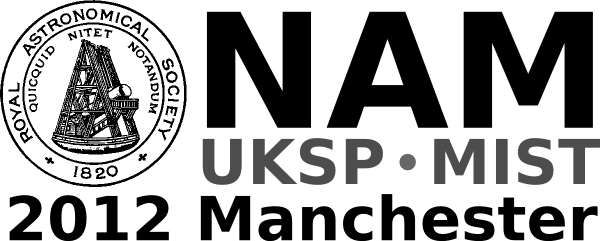UK-Germany National Astronomy Meeting NAM2012
When dark energy turned on
Royal Astronomical Society press release
RAS PR 12/32, NAM 23
30 March 2012

The record of baryon acoustic oscillations (white rings) in galaxy maps helps astronomers retrace the history of the expanding universe.
The Sloan Digital Sky Survey (SDSS-III) today announced the most accurate measurements yet of the distances to galaxies in the faraway universe, giving an unprecedented look at the time when the universe first began to expand at an ever-increasing rate. Scientists from the University of Portsmouth and the Max-Planck Institute for Extraterrestrial Physics will present the new results in a press conference at 1000 BST on Friday 30 March at the National Astronomy Meeting in Manchester [details are given below].
The results are available in six related papers posted to the arXiv preprint server and are the culmination of more than two years of work by the team of scientists and engineers behind the Baryon Oscillation Spectroscopic Survey (BOSS), one of the SDSS-III's four component surveys.
"There's been a lot of talk about using galaxy maps to find out what's causing accelerating expansion," says David Schlegel of the U.S. Department of Energy's Lawrence Berkeley National Laboratory, the principal investigator of BOSS. "We've been making a map, and now we're using it - starting to push our knowledge out to the distances when dark energy turned on."
"The result is phenomenal," says Will Percival, a professor at the University of Portsmouth in the United Kingdom, and one of the leaders of the analysis team. "We have only one-third of the data that BOSS will deliver, and that has already allowed us to measure how fast the Universe was expanding six billion years ago - to an accuracy of two percent."
One of the most amazing discoveries of the last two decades in astronomy, recognized with the 2011 Nobel Prize in Physics, was that not only is our universe expanding, but that this expansion is accelerating - not only are galaxies are becoming farther apart from each other, they are becoming farther apart faster and faster.
What could be the cause of this accelerating expansion? The leading contender is a strange property of space dubbed "dark energy." Another explanation, considered possible but less likely, is that at very large distances the force of gravity deviates from Einstein's General Theory of Relativity and becomes repulsive.
Whether the answer to the puzzle of the accelerating universe is dark energy or modified gravity, the first step to finding that answer is to measure accurate distances to as many galaxies as possible. From those measurements, astronomers can trace out the history of the universe's expansion.
BOSS is producing the most detailed map of the universe ever made, using a new custom-designed spectrograph of the SDSS 2.5-meter telescope at Apache Point Observatory in New Mexico. With this telescope and its new spectrograph, BOSS will measure spectra of more than a million galaxies over six years. The maps analyzed in today's papers are based on data from the first year and a half of observations, and contain more than 250,000 galaxies. Some of these galaxies are so distant that their light has travelled more than six billion years to reach the earth - nearly half the age of the universe.
Maps of the universe like BOSS's show that galaxies and clusters of galaxies are clumped together into walls and filaments, with giant voids in between them. These structures grew out of subtle variations in density in the early universe, which bore the imprint of "baryon acoustic oscillations" - pressure-driven (acoustic) waves that passed through the early universe.
Billions of years later, the record of these waves can still be read in our universe. "Because of the regularity of those ancient waves, there's a slightly increased probability that any two galaxies today will be separated by about 500 million light-years, rather than 400 million or 600 million," says Daniel Eisenstein of the Harvard-Smithsonian Center for Astrophysics, director of SDSS-III and a pioneer in baryon oscillation surveys for nearly a decade. In a graph of the number of galaxy pairs by separation distance, that magic number of 500 million light years shows up as a peak, so astronomers often speak of the "peak separation" between galaxies. The distance that corresponds to this peak depends on the amount of dark energy in the Universe. But measuring the peak separation between galaxies depends critically on having the right distances to the galaxies in the first place.
That's where BOSS comes in. "We've detected the peak separation more clearly than ever before," says Nikhil Padmanabhan of Yale University, who along with Percival co-chairs the BOSS team's galaxy clustering group. "These measurements allow us to determine the contents of the Universe with unprecedented accuracy."
In addition to providing highly accurate distance measurements, the BOSS data also enable a stringent new test of General Relativity, explains Beth Reid, a NASA Hubble Fellow at Lawrence Berkeley National Laboratory. "Since gravity attracts, galaxies at the edges of galaxy clusters fall in toward the centres of the clusters," Reid says. "General Relativity predicts just how fast they should be falling. If our understanding of General Relativity is incomplete, we should be able to tell from the shapes we see in BOSS's maps near known galaxy clusters."
Reid led the analysis of these "redshift space distortions" in BOSS. After accounting for the effects of dark energy, Reid's team found that the rate at which galaxies fall into clusters is consistent with Einstein's predictions. "We already knew that the predictions of General Relativity are extremely accurate for distances within the solar system," says Reid, "and now we can say that they are accurate for distances of 100 million light-years.
We're looking a billion times further away than Einstein looked when he tested his theory, but it still seems to work."
What's amazing about these results - six papers covering the measurements of cosmic distance and the role of gravity in galaxy clustering - is that they all come together to tell the same story. "All the different lines of evidence point to the same explanation," says Ariel Sanchez, a research scientist at the Max Planck Institute for Extraterrestrial Physics in Garching, Germany, and lead author on one of the papers. "Ordinary matter is only a few percent of the universe. The largest component of the universe is dark energy - an irreducible energy associated with space itself that is causing the expansion of the universe to accelerate."
But this is just the beginning, says BOSS principal investigator Schlegel. "For the past 13 years, we've had a simple model of how dark energy works. But the truth is, we only have a little bit of data, and we're just beginning to explore the times when dark energy turned on. If there are surprises lurking out there, we expect to find them."
IMAGE AND CAPTION
An illustration can be downloaded from http://bit.ly/sdss30mar2012
Short Caption: The record of baryon acoustic oscillations (white rings) in galaxy maps helps astronomers retrace the history of the expanding universe.
More information about the image:
The record of baryon acoustic oscillations (white rings) in galaxy maps helps astronomers retrace the history of the expanding universe.
These schematic images show the universe at three different times. The false-colour image on the right shows the "cosmic microwave background," a record of what the very young universe looked like, 13.7 billion years ago. The small density variations present then have grown into the clusters, walls, and filaments of galaxies that we see today. These variations included the signal of the original baryon acoustic oscillations (white ring, right).
As the universe has expanded (middle and left), evidence of the baryon oscillations has remained, visible in a "peak separation" between galaxies (the larger white rings).
The SDSS-III results announced today (middle) are for galaxies 5.5 billion light-years distant, at the time when dark energy turned on. Comparing them with previous results from galaxies 3.8 billion light-years away (left) measures how the universe has expanded with time.
Credit: E. M. Huff, the SDSS-III team, and the South Pole Telescope team. Graphic by Zosia Rostomian.
PRESS CONFERENCE, 0900 GMT (1000 BST), FRIDAY 30 MARCH, UNIVERSITY OF MANCHESTER
Science team members Will Percival, Ashley Ross, Ariel Sanchez and Rita Tojeiro will give a press conference in the Lovell Seminar Room (3.225) in the Alan Turing Building, University of Manchester. The conference will be webcast via http://www.ustream.tv/channel/jbca
To post questions to speakers during the conference please email Robert Massey or Anita Heward (details below).
The emergency direct dial phone number for the Lovell Room is +44 (0)161 275 4207 but note that we will NOT be running a telephone conference system.
MEDIA CONTACTS
NAM 2012 Press Office (0900 - 1730 BST, 27-29 March; 0900 - 1630 BST 30 March)
Room 3.214
University Place building
University of Manchester
Manchester
UK
Tel: +44 (0)161 306 7313
Dr Robert Massey
Royal Astronomical Society
Mob: +44 (0)794 124 8035
Email: rm@ras.org.uk
Anita Heward
Royal Astronomical Society
Mob: +44 (0)7756 034 243
Email: anitaheward@btinternet.com
Dr Klaus Jaeger
Pressereferent / Press Officer im Vorstand der Astronomischen Gesellschaft
Tel: +49 6221 528 379
Email: pressereferent@astronomische-gesellschaft.de
Dan Cochlin
Media Officer (Faculty of Engineering and Physical Sciences)
University of Manchester
Tel: +44 (0)161 275 8387
Email: daniel.cochlin@manchester.ac.uk
Lisa Egan
University of Portsmouth (UK)
Tel: +44 (0)23 9284 3748
Email: lisa.egan@port.ac.uk
Michael Wood-Vasey
SDSS-III Spokesperson
University of Pittsburgh (USA)
Tel: +1 617 230 2758
Email: wmwv@pitt.edu
Jordan Raddick
SDSS-III Public Information Officer
Tel: +1 443 570 7105
Email: raddick@jhu.edu
SCIENCE CONTACTS
Will Percival
University of Portsmouth (UK),
Mob: +44 (0)797 456 4017
Email: will.percival@port.ac.uk
Ashley J. Ross
University of Portsmouth (UK),
Mob: +44 (0)794 333 4006
Email: ashley.ross@port.ac.uk
Rita Tojeiro
University of Portsmouth (UK)
Email: rita.tojeiro@port.ac.uk
Ariel Sanchez
Max Planck Institute for Extraterrestrial Physics (Germany)
Tel: +49 (0)176 8006 3852
Email: arielsan@mpe.mpg.de
NOTES FOR EDITORS
ABOUT SDSS-III
Funding for SDSS-III has been provided by the Alfred P. Sloan Foundation, the Participating Institutions, the National Science Foundation, and the U.S. Department of Energy Office of Science.
The SDSS-III web site is www.sdss3.org
SDSS-III is managed by the Astrophysical Research Consortium for the Participating Institutions of the SDSS-III Collaboration including the University of Arizona, the Brazilian Participation Group, Brookhaven National Laboratory, University of Cambridge, Carnegie Mellon University, University of Florida, the French Participation Group, the German Participation Group, Harvard University, the Instituto de Astrofisica de Canarias, the Michigan State/Notre Dame/JINA Participation Group, Johns Hopkins University, Lawrence Berkeley National Laboratory, Max Planck Institute for Astrophysics, Max Planck Institute for Extraterrestrial Physics, New Mexico State University, New York University, Ohio State University, Pennsylvania State University, University of Portsmouth, Princeton University, the Spanish Participation Group, University of Tokyo, University of Utah, Vanderbilt University, University of Virginia, University of Washington, and Yale University.
NAM 2012
Bringing together more than 900 astronomers and space scientists, the National Astronomy Meeting (NAM 2012) will take place from 27-30 March 2012 in the University Place conference centre at the University of Manchester in the UK. The conference is a joint meeting of the Royal Astronomical Society (RAS) and the German Astronomische Gesellschaft (AG) and is held in conjunction with the UK Solar Physics (UKSP: www.uksolphys.org) and Magnetosphere Ionosphere Solar Terrestrial (MIST: www.mist.ac.uk) meetings. NAM 2012 is principally sponsored by the RAS, AG, STFC and the University of Manchester.
The Royal Astronomical Society
The Royal Astronomical Society (RAS: www.ras.org.uk), founded in 1820, encourages and promotes the study of astronomy, solar-system science, geophysics and closely related branches of science. The RAS organises scientific meetings, publishes international research and review journals, recognizes outstanding achievements by the award of medals and prizes, maintains an extensive library, supports education through grants and outreach activities and represents UK astronomy nationally and internationally. Its more than 3500 members (Fellows), a third based overseas, include scientific researchers in universities, observatories and laboratories as well as historians of astronomy and others.
The Astronomische Gesellschaft (AG)
The Astronomische Gesellschaft (AG: www.astronomische-gesellschaft.de), founded in 1863, is a modern astronomical society with more than 800 members dedicated to the advancement of astronomy and astrophysics and the networking between astronomers. It represents German astronomers, organises scientific meetings, publishes journals, offers grants, recognises outstanding work through awards and places a high priority on the support of talented young scientists, public outreach and astronomy education in schools.
The Science and Technology Facilities Council
The Science and Technology Facilities Council (STFC: www.stfc.ac.uk) is keeping the UK at the forefront of international science and tackling some of the most significant challenges facing society such as meeting our future energy needs, monitoring and understanding climate change, and global security. The Council has a broad science portfolio and works with the academic and industrial communities to share its expertise in materials science, space and ground-based astronomy technologies, laser science, microelectronics, wafer scale manufacturing, particle and nuclear physics, alternative energy production, radio communications and radar. It enables UK researchers to access leading international science facilities for example in the area of astronomy, the European Southern Observatory.
Jodrell Bank Centre for Astrophysics
The Jodrell Bank Centre for Astrophysics (JBCA: www.jb.man.ac.uk) is part of the School of Physics & Astronomy at the University of Manchester. JBCA is split over two main sites: the Alan Turing Building in Manchester and the Jodrell Bank Observatory in Cheshire. At Jodrell Bank Observatory, the new Jodrell Bank Discovery Centre is a key focus for our work in public engagement and education. Jodrell Bank is a world leader in radio astronomy-related research and technology development with a research programme extending across much of modern astrophysics. The group operates the e-MERLIN national radio astronomy facility and the iconic Lovell Telescope, hosts the UK ALMA Regional Centre Node and is home to the international office of the SKA Organisation. Funded by the University, the Science & Technology Facilities Council and the European Commission, it is one of the UK's largest astrophysics research groups.





